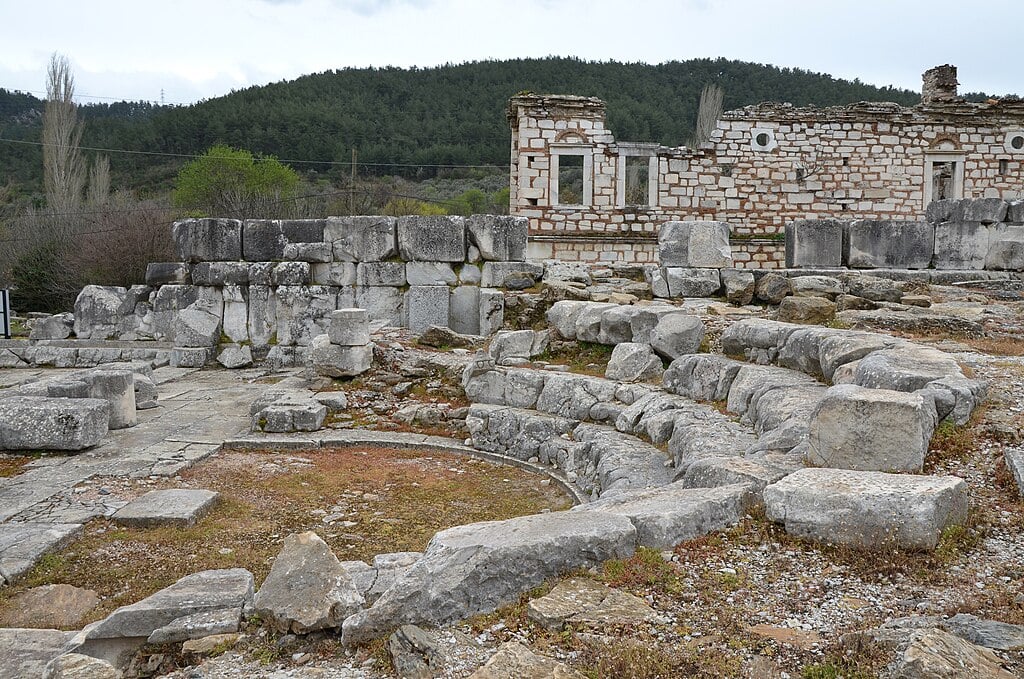

The assembly hall at the ancient Hellenistic city of Stratonikeia, also known as the “City of Gladiators,” located in modern-day Muğla Province, Turkey is being restored to its former glory with the goal to allow visitors to see its grandeur as it was in ancient times.
The announcement was made by professor Bilal Söğüt, Head of the Stratonikeia and Lagina Excavation Team, who said that the current restoration efforts are focusing on the assembly hall, one of the ancient city’s most central structures.
“There’s a calendar made by the ancient philosopher Menippos on the building,” Söğüt told the state-run Anadolu Agency. “Furthermore, from the Roman period, there are lists of all goods sold and services offered in Stratonikeia, along with their maximum prices. The building is significant both as an assembly hall and for the inscriptions, from both the ancient and Ottoman periods found on it.”
Stating that the area where the 2,200-year-old assembly hall is located reflects multiple historical periods simultaneously, Söğüt added that his team completed the restoration of the infrastructure in the inscriptions section at the northern entrance and fully re-erected a column measuring nearly nine meters high. The aim, according to the restoration team, is for the visitors to eventually be able to see the assembly hall as it once was, including its seating rows, two entrance doors, and the full height and majesty of its columns.
Noting that their aim to preserve and exhibit structures and architectural elements in their original locations as a legacy for future generations, Söğüt said, “We only carry out restoration where about 90 percent of the original material is available. That was the case here. To preserve the steps of the structure, we added new supports to the edges. The assembly hall’s north and south entrances have been restored in their original locations and now reflect their ancient splendor. We also completed the column drums with marble.”
Restoration works are part of the “Heritage for the Future” project while excavation and restoration works continue throughout the year.

According to ancient Greek Geographer Strabo, the ancient city of Stratonikeia was founded by the Seleucid king Antiochus I Soter (281–261 BC), a Greek ruler from the dynasty that emerged after the conquests of Alexander the Great. Antiochus named the city after his wife, Stratonice, which translates as “Victorious Army,” reflecting the Seleucids’ cultural and political legacy rooted in Alexander’s empire.
In 2024, a massive sewage system that still works and is big enough to walk in has been discovered in the ancient Hellenistic city of Stratonikeia (Ancient Greek: Στρατoνικεια ).
The sewer dates back to more than 2,250 years ago, yet it has functioned properly since. This engineering marvel, along with other discoveries, is a testament to the advanced building capabilities of the ancient Romans.
“Water is still flowing away [on its own] even after 2,250 years. That’s why we are incredibly happy,” said Dr. Bilal Söğüt, the head of the Stratonikeia Ancient City Excavation Team. “The discovery of the sewage system reveals the historical richness of the region and the lifestyle of ancient settlements.”
Söğüt noted the expertise of the ancient Romans in creating such an intricate sewage system. “All these sewage systems are connected to the streets and flow towards the stream, discharging without causing any discomfort to the city,” the expert stated, adding, “The discovery of the sewage system reveals the historical richness of the region and the lifestyle of ancient settlements.”
The archaeological site where the sewers were found is home to some of the most insightful and educational ruins of the ancient Greeks, along with the Roman and Byzantine empires. In addition to the ancient Roman sewage systems, the same team of archaeologists found 3,000-year-old artifacts in an ancient Greek temple in what was once the ancient city of Hekate.
